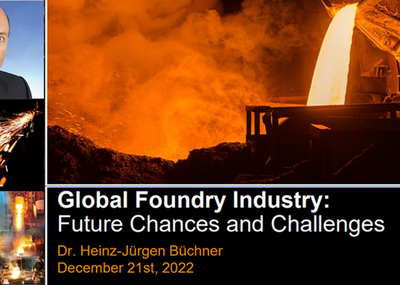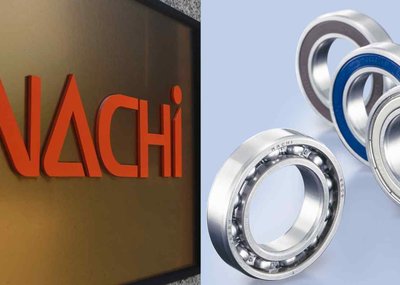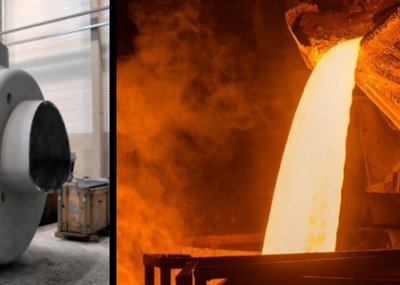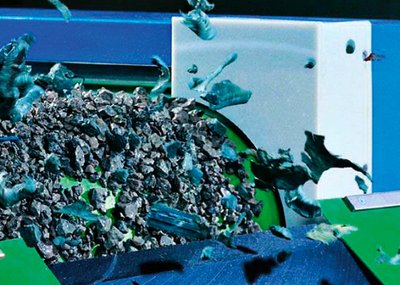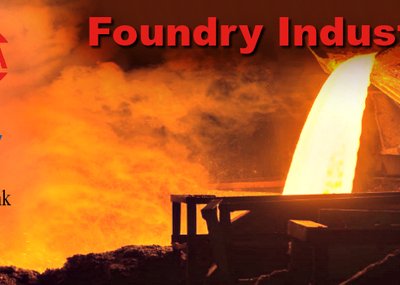By Dr. Heinz-Jürgen Büchner, Managing Director of Industrials & Automotive, responsible for the metal industry and responsible for various analyzes of IKB Deutsche Industriebank
With its services, IKB Deutsche Industriebank is primarily geared towards medium-sized companies in Germany. IKB employees regularly publish articles in analog and digital media and give lectures at industry events. A forecast for the development of the foundry industry through 2025.
2020 will see the sharpest decline in global economic output since the end of WWII. While the original outlook for 2020 had expected a reasonably normal increase in world trade and global gross domestic product (GDP), the outbreak of the coronavirus pandemic in China at the beginning of the year had the opposite effect.
Although China was the first to implement a lockdown, it will also be the only country of the leading economies that will achieve a small increase in gross domestic product. China responded immediately to the outbreak of the pandemic with a strict local closure of some regions. This not only affected the automotive industry and its suppliers, but also to a considerable extent the casting and metal industries due to disruptions in the logistics chains. However, there was also a rapid recovery in the economy, so that a so-called “V-shaped curve” of GDP is expected here.
Within the EU, the slump in Italy, Spain and France is more serious than in Germany. But in Germany, too, there are only signs of a slow recovery for the time being. Reducing workers‘ hours is an important instrument for securing employment, but at the same time means a significant loss of purchasing power for private households. This has a correspondingly negative impact on private consumption. Overall, a “U-shaped course” of the economic framework conditions can be assumed in the EU, which will drag on well into the second half of 2021.
The recovery in Europe in 2021 is weaker because the UK leaves the EU with an very weak agreement. As of October 2020, the sharp rise in infection numbers has also had a negative impact on a number of countries, which is likely to dampen an economic recovery in the firth quarter of 2021. No major lockdown has yet been announced in the USA. The renewed strong increase in the number of infections ensures that, at best, a weak recovery will be possible in the firth quarter of 2021. The decisive factor will be how the new government reacts to the challenges of the pandemic and whether there will be a stronger orientation towards the most important global trading partners in the future.
Automotive industry puts pressure on casting production
In the years between 2013 and 2017, global automobile production expanded strongly; In the two following years 2018 and 2019, however, it fell again. The year 2020 is now marked by the coronavirus crisis; Production of just under 72 million light vehicles (LV) is expected at best, which means a global slump of around 20%. Europe and North America were hardest hit; in China, however, there have been positive sales reports again since April. No complete catch-up effect is seen for the year 2021, and the IKB anticipates an increase to approx. 80 million LV worldwide.
The catching-up process takes a relatively long time: the production level of 2019 will not be exceeded until 2024, that of 2018 should not be reached until 2026 at the earliest. This time, the way out of the crisis in the automotive industry is much more protracted than in the economic crisis in 1993 or the financial crisis in 2007/09. The production of medium and heavy vehicles showed a sharp drop in 2020: the global production of commercial vehicles will collapse by around a quarter. The pre-crisis level will not be reached again by 2025.
However, while Chinese car production is already recovering, the commercial vehicle segment in China is continuing to decline. Towards the end of the period under review, production in China is roughly at the level of 2016. However, there has also been a significant modernization, for example of the truck fleet in this country, in recent years. In contrast, the recovery process in Europe is taking place much faster, with the levels of 2019 possibly being reached as early as 2023. However, the decline in global car and commercial vehicle production is having a negative impact on global casting production in the current year. Slumps in the main customer industry for cast parts can only be compensated for with great difficulty by other customer industries, especially since production losses are also occurring there.
Mechanical engineering in difficult waters
The global demand for mechanical engineering products is unlikely to slowly pick up again until the course of 2021. In the current economic environment with underutilization of capacities, companies naturally hold back with investments. Sales in China will be the first to recover after the decline, but here, too, the ongoing trade conflict with the USA is dampening willingness to invest. The trade conflicts between the USA and partners including Germany and the EU, also have a negative impact on international demand for mechanical engineering products.
Mechanical engineering production is primarily burdened by the lower demand from the automotive industry and the geopolitical disputes. The collapse in exports from many other customer industries and the significant drop in capacity utilization, especially in the USA and important emerging countries, are slowing down the willingness to invest in new machines and systems, not only in Germany.
In 2019, the total construction output in Europe grew by 2.9%, mainly driven by new construction projects. A significant decline in growth was expected for 2020 due to the weakening economy. In the course of the shutdown, several construction sites in Spain, France and Italy were idle for long periods of time, which leads to corresponding delays in completion and in some cases has consequences until 2021.
Despite the significant declines in growth in 2020 due to the coronavirus pandemic, the construction industry is expected to recover in 2021 and 2022. However, growth rates will be lower than before the pandemic. Growth in residential and commercial construction is expected to have declined by 8% in Western Europe in 2020, but also to increase again by around 3% to 5% p.p. over the next two years. The expected decline in Eastern Europe - but also in Germany - is significantly lower. The implementation of the infrastructure programs announced by the EU and many member states will also be decisive for the recovery of the European construction industry.
Casting production collapses in 2020
Between 2016 and 2018, global production of iron and cast steel materials increased by 10% to 90.2 million t. China played a major role in this, as it produced 41.2 million tons of good castings in 2018. For comparison: In 2000 it was only 9.9 million t, so production has quadrupled since the beginning of the millennium. China is also likely to experience a setback in production in 2020.
However, IKB is still assuming an output of at least 35 million t, which could be significantly higher if the infrastructure investments decided upon were implemented quickly. They assume a production of around 76 million tons of cast iron materials worldwide. This means a production loss of around 16% compared to 2018. The decrease is therefore somewhat smaller compared to the total production of light vehicles, since other customer industries - such as construction-related cast applications - have been much more stable. The sharpest decline in 2020 will be in Western Europe, where we expect a production slump of up to a quarter. The longest lockdowns occurred here, and the recovery of the automotive industry also began slowly at first. In NAFTA, Eastern Europe and the rest of the world, on the other hand, production only drops by 14 to 15% each.
Covid-19 pandemic hit the industrial heart of Western Europe
The decline in the production of iron, steel and malleable cast iron is very different in Europe. We see the sharpest drop in cast output in Italy. The focus of the first wave of pandemics hit the industrial heart of Italy with the regions Lombardy, Piedmont and Veneto particularly hard. Not only the automotive industry, mechanical engineering and large parts of metal processing are located here, but also many foundries with an international reputation and at least Europe-wide supply chains.
But the German foundries also suffered a significant drop in sales in 2020. In addition to lower calls from the automotive industry, the temporary disruptions in the supply chain in other industries also dampened demand. The Eastern European foundries are getting through the crisis somewhat better because of the pent-up demand, especially in Russia and Ukraine, but also because of the weaker lockdown measures - even in Turkey these have largely failed to materialize.
Overall, however, we see a recovery process in the production of cast iron materials in Europe in 2021 and 2022. However, the pre-crisis level will only be reached briefly at best. The tonnage generated is likely to decline again between 2022 and 2025. One of the main reasons for this is the trend towards lightweight construction and the continued advance of e-mobility in car production. If a classic combustion engine including its peripherals is replaced by a complete battery, the total weight of the light vehicle increases. This applies even to a battery housing made of cast aluminum. But then weight has to be removed from the vehicle elsewhere. This can be done, for example, in the area of structural components, but also with other cast components.
Just through the effect of making existing cast parts - whether engine blocks, oil sumps or other castings - lighter, significant tonnages will be lost in the next five years. In addition, there is material substitution by aluminum for many parts. The fact that casting production in Spain will remain comparatively stable in this forecast is due, among other things, to wind turbine casting. The foundries there will benefit from the expansion of offshore wind generation, which is required by the relevant regulations. The Eastern European foundries benefit from the need to invest in infrastructure in Russia and Ukraine, among others, but also from good growth prospects in Turkey.
IKB also increasingly expects casting production to be relocated from Western Europe to Eastern Europe. This applies in spite of the rising wage costs in many Eastern European countries. At the same time, post-processing can be done much more cost-effectively there. In addition, the proximity to the OEM, who are expanding production capacities there, is often a decisive location factor. With regard to cast iron materials, we see further relative market share gains by spheroidal graphite cast iron and vermicular graphite cast iron at the expense of gray cast iron.
Cast aluminum with recovery potential
The global production of cast aluminum has also suffered a setback in the past year: At 16.8 million t, total production is likely to be a good 10% lower than in 2018. China set another production record in 2018 with 7.2 million tons. Compared to 2000, this was nine times the tonnage at the time. We expect only a slight decline in Chinese cast aluminum production to around 7 million tons in 2020. The declines in the NAFTA region, Western Europe and the rest of Asia will each amount to between 15 and 18%.
The lower casting output in the rest of Asia is mainly due to the falling production in India and the declines in Japan and South Korea. The last two countries will lose production capacities to China in the long term. In addition, countries such as Vietnam and Indonesia must also be given greater focus in the medium term. This is where new capacities are built up. In contrast, IKB is forecasting production losses of only around 10% for Eastern Europe. Above all, the construction of new locations for international foundry groups has had a positive effect on the tonnage generated. In terms of the recovery process, IKB sees a new production record in 2022. However, this assumes that there will not be any major production interruptions in the global automotive and mechanical engineering industries in 2021 and 2022.
China is likely to increase its annual aluminum casting production towards 8 million tons. But substitution successes are to be expected in Western Europe and NAFTA, both at the expense of other materials and other manufacturing technologies. The structural components segment in particular still offers great opportunities here. For example, Tesla wants to manufacture large, complete aluminum cast parts for its e-vehicles and has accordingly invested in new casting machines. For example, the rear floor panel of his new model Y is to be made from four components instead of 70 parts. In a further step, this floor slab is then to be created completely from one cast.
Other OEMs are considering similar projects. However, casting machines with clamping forces in the range of around 6000 t are also necessary for this. Within Western Europe, Germany will be able to maintain its position as the leading aluminum casting producer. Italy should also show a faster recovery again. Eastern Europe including Turkey will show the strongest growth overall. In addition to Slovakia, Hungary and Romania, some smaller countries such as Croatia should also improve. Turkey has so far benefited from high foreign investments, but has recently lost a massive amount of reputation - due to interventions in the independence of the central bank combined with a sharp drop in the exchange rate and political irritation.
Industry before consolidation
Last but not least, the drop in production in 2020 will accelerate the consolidation process. In addition to a few bankruptcies - which are not always accompanied by a reduction in capacity - there will be more takeovers and joint ventures. Many smaller groups of companies will no longer be able to cope with future investment needs, for example in aluminum casting. However, larger company units also improve their negotiating position in relation to the mostly considerably larger customer groups.
After the Covid-19 pandemic, a stronger sense of proportion is required here. Additional savings would bring many foundries to the edge of their existence. The German automotive industry has so far benefited from the technological performance and development expertise of its casting partners. It is important to maintain this.
Dr. Heinz-Jürgen Büchner, IKB Deutsche Industriebank AG, is the Managing Director Industrials & Automotive responsible for the metal industry and for the bank's raw material analyses.



